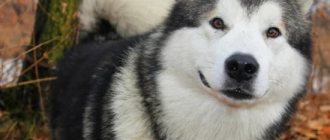The Doberman is a strong and intelligent dog. The breed was bred for service purposes, but now these dogs are not as aggressive as before. They are graceful, smart and loyal. Often used for guarding or protection, but can become a companion or pet. They have a very keen sense of smell and a developed instinct to protect their territory. Therefore, the Doberman breed has remained one of the most popular for many years.
- Head
- Training
- Nutrition
Breed traits
Breed traits (on a 5-point scale)
| Doberman (Doberman pinscher) | |||
| Activity | in the house | 2.9 | |
| on the street | 4.3 | ||
| Obedience | training | 4.2 | |
| strangers | 4 | ||
| Domination | in family | 2.1 | |
| over dogs | 2.8 | ||
| Defending your territory | from people | 3.5 | |
| from dogs | 3.6 | ||
| Sociability | in family | 4.9 | |
| with strangers | 3.1 | ||
| with dogs | 3.2 | ||
| Concentration | in family | 1.1 | |
| in front of strangers | 2.2 | ||
| with dogs | 2 | ||
| Aggressiveness | in family | 1.1 | |
| to strangers | 2.6 | ||
| to the dogs | 2.5 | ||
| to cats | 3 | ||
| Family behavior | calmness | 4.5 | |
| demand for affection | 4.6 | ||
| excitability | 4.1 | ||
| playfulness | 4.3 | ||
| excessive barking | 2.1 | ||
| behavioral breakdowns | 2.2 | ||
| Tolerance for children | up to 4 years | 3.4 | |
| over 4 years old | 3.8 | ||
| Institutional use | watchman | 4.7 | |
| bodyguard | 3.5 | ||
This breed is often compared to the following dog breeds: German Shepherd, Great Dane, American Staffordshire Terrier, Bull Terrier, Rottweiler.
Photos show how beautiful and elegant Dobermans are:
Age, compared to human years
To better understand the social intelligence and emotional sphere of dogs, their age is compared with humans:
| Doberman's age (in years) | Person's age (in years) |
| 2 months | 14 months |
| 6 months | 5 |
| 8 months | 9 |
| 1 | 14 |
| 1,5 | 20 |
| 2 | 24 |
| 3 | 30 |
| 4 | 36 |
| 5 | 40 |
| 6 | 42 |
| 7 | 49 |
| 8 | 56 |
| 9 | 63 |
| 10 | 65 |
| 11 | 71 |
| 12 | 75 |
| 13 | 80 |
| 14 | 84 |
| 15 | 87 |
Doberman: general characteristics
The Doberman is an artificially bred breed. Its founder, Louis Dobermann, had the goal of having a strong, fearless and intelligent defender. Therefore, he crossed the most intelligent, hardy and evil dogs. The first dogs were even aggressive and were used for police service and security. Now Dobermans have become calmer and safer dogs, retaining all other positive qualities.
Now this is a universal breed. Doberman is a protector, guard, devoted friend, companion. This temperamental, strong dog treats all people kindly, and provides security for its family members, protecting them from any threats. Representatives of this breed are hardy, strong and efficient. They have a very sensitive sense of smell, which is why Dobermans are included in the Guinness Book of Records.
Thanks to their natural intelligence, intuition and quick wit, they are easy to train and can be taught anything. These pets are inquisitive, love to learn, and are able to make independent decisions, so it is very important to direct their energy in the right direction. With proper upbringing, this pet will become a source of pride for its owners. After all, elegance and proud posture make the Doberman an aristocrat among other dogs.
The photographs show that these dogs are often used for police service:
Police service
Service dog
It is safest to keep this dog in a private house with its own territory. But Dobermans live well in a city apartment. The main thing is to walk a lot with your pet, as it needs a lot of physical activity. It is also not advisable to have a Doberman in a small apartment, as it is a rather large breed. The height of a male dog at the withers can reach 72 cm, and weight – 45 kg. The lifespan of this pet is 14-16 years, some individuals live up to 20 years.
A description of the main qualities and characteristics of representatives of this breed can be found in the table
| Parameter | Characteristic |
| Aggressiveness | Average, depends on upbringing |
| Activity | Tall, you need to walk for at least 2 hours, very hardy and strong |
| Intelligence | Tall, smart, independent, developed intuition |
| Goodwill | Kind to family members, safe for others if raised properly |
| Working qualities | Watchman, protector, can work in the police, search service, as a guide |
| Health | good |
| Care | Uncomplicated, the dog is unpretentious, does not smell, almost does not shed |
| Training | Difficult, listens only to a person who can become an authority for him |
Pros of the breed
Dobermans have many positive qualities, which is why they have become popular not only in the field of service dog breeding, but also among ordinary fanciers. The most commonly noted advantages of these pets are:
- the versatility of the breed is manifested in the fact that Dobermans can be used for security, police service, and search and rescue work;
- they can work as guides for the blind;
- boundless devotion to the owner;
- elegant appearance;
- high intelligence and great learning abilities;
- balanced psyche;
- strength, endurance, fearlessness.
Why you should have this pet can be seen in the photographs:
Cons of the breed
But before you get a Doberman, you need to find out what disadvantages this dog has. A pet is not suitable for everyone; if raised incorrectly, it can become angry, aggressive and uncontrollable. It requires an active owner who can become an authority and communicate with the animal calmly and firmly. But a Doberman should not be owned by unbalanced people, those who like to sit at home or those who are phlegmatic. Most often, reviews note the following disadvantages of these dogs:
- recognizes only an authoritative owner;
- they are stubborn, capricious, and can make their own decisions;
- sometimes they are aggressive, they can fight with other dogs, they rush at people;
- They definitely need high physical activity and long walks.
An interesting video will tell you about the pros and cons of this breed:
Signs of aging
The fact that the pet has entered the last stage of life can be guessed by the following age characteristics:
- the dog became less active and playful;
- he gets tired faster;
- his fur and eyes lost their shine;
- the condition of the teeth has worsened.
Such a dog needs special attention:
- exercise less on walks;
- feed only high-quality products;
- give vitamins and minerals;
- take you for preventive examinations more often.
Dobermans can live a long life if their owners comply with a number of conditions. It is important to take good care of your pet, feed it the right food and give it the necessary mental and physical exercise. It is worth considering that this breed is prone to certain diseases, so annual veterinary examinations are the key to Doberman health.
Story
The Doberman is a German dog, its homeland is Germany. The creator of the breed, Karl Louis Dobermann, served in the night police and was a tax collector. He decided to breed a dog that would help him in his difficult service. According to his idea, it should be a small, smooth-haired dog, physically tough and smart. Appearance was not taken into account, the main thing was performance.
Dobermann began breeding at the end of the 19th century. No records were kept, so it is unknown what breeds were used. Probably, pinschers, shepherd dogs, Great Danes, Pointners, Rottweilers, and mastiffs participated in the breeding. Just 20 years later, in 1890, an amazing dog was created that immediately became popular. It was bought for security and police service. At first the breed was called the Thuringian Pinscher. After the death of the creator, “Doberman” was added to the name “pinscher”.
Otto Geller continued the work of Dobermann. He softened the aggressiveness of the new breed a little and made the dogs more obedient and kind. It is he who is considered the creator of the modern breed; under him, these dogs spread throughout Europe. Already in 1899, a club for Doberman Pinscher lovers was created.
Dobermans appeared in Russia at the very beginning of the 20th century. At first they were used for service in the police and army. But due to the revolution and civil war, representatives of the breed were almost destroyed. And during the Great Patriotic War, these dogs were actively used at the front. Dobermans served as sappers, scouts, and messengers.
The breed survived after World War II thanks to the efforts of dog breeders from the USA. In the middle of the 20th century, the word “pinscher” was removed from the name. Now the breed is called "Doberman". This is the only breed named after its creator. She was recognized and officially entered into the register in the Pinscher and Schnauzer section. It belongs to the group of working breeds.
For many years now, the breed has been one of the top popular pets and is included in the top ten smartest dogs. Since the 70s of the 20th century, Dobermans have been bred not only for official purposes, they have become pets.
Breed standard
Dobermans are fairly large, elegant dogs with a strong build. But they are not massive, rather graceful. They are characterized by nobility of posture and endurance. They have a proportional build, harmoniously combining power with elegance and even sophistication. The height of Dobermans is above average - for males 68-72 cm, for females 63-68 cm. Weight is 40-45 kg, for females - 32-35 kg.
The appearance of Dobermans has remained almost unchanged since their creation. Only now has tail and ear docking, originally adopted by the German standard, become optional. In some countries, this procedure is even prohibited, so docked dogs may be disqualified at international exhibitions. The current standard, adopted in 2015, recognizes both options.
Head
The head is proportional in shape and size to the body. When viewed from above, it has a wedge-shaped elongated shape. The line of the crown is straight, the stop is clearly defined. No drooping cheeks. The mouth is wide, the jaws are well developed. The teeth are strong, with a scissor bite. The nose is wide, almost square, black. Brown individuals may have a lighter color. The eyes are oval, medium-sized, and should be dark in color. But light-colored dogs can be light brown.
The ears are set high. Uncropped - medium in size, hanging, the leading edge is adjacent to the cheeks. But for many, the appearance of a Doberman with cropped ears is more familiar. Then they are erect, pointed upward, and mobile.
What a dog's head should be according to the standard can be seen from the photo:
Torso
Dobermans have a strong build and strong bones. These are lean, hardy and strong dogs. Proportional build is expressed in the fact that they have an almost square body - the height at the withers is equal to the length of the body.
The neck is long, muscular, straight. The withers are prominent, the loin is short, the croup is rounded. The chest is wide, convex, the stomach is tucked. The tail is set high, and when docked it is very short - only 2 vertebrae remain. If a Doberman has an undocked tail, it is long, thin,
Limbs
Legs are straight, vertical, well developed. The front ones are set parallel, at right angles to the body. Their length is proportional. The hind legs have clearly defined muscles, rounded hips and knees. The paws are short, gathered into a ball. The movements of these dogs are light and sweeping. They run fast, but elegantly and beautifully.
The photographs show what a Doberman should look like according to the standard:
Doberman ear and tail docking
Previously, the ears and tail of Dobermans were always cropped. The tail was shortened some time after birth; only 2 vertebrae were supposed to be left. The ears are cropped later, at 1.5-2 months. Now this procedure is common only in Russia and the CIS countries.
Docking is rarely performed on adult dogs, as it is more difficult for them to endure anesthesia and post-operative recovery. It is necessary to use a special device to ensure that the ears become correctly. Some dogs have to wear such a crown for several months. Therefore, before docking, you need to think about whether it is worth torturing your pet like this. If he will not be exhibited, you can leave his natural ears and tail.
In many countries, docking has not been carried out since the 80s of the 20th century. This procedure is considered cruel, which is why representatives of this breed with undocked ears and tail are common. The standard recognizes both options, but at German and other European shows, docked individuals may be disqualified.
From photographs of purebred representatives of the breed, it is clear that both cropped and natural ears are allowed:
Docked
Undocked
Coat and color
The fur of representatives of this breed is short, hard, and thick. It fits tightly to the body, smooth and shiny. There is no undercoat. Now there are 4 common colors of Dobermans: black and tan, brown, blue and fawn. Initially, when the breed appeared, only one color was recognized. Therefore, black Dobermans are still the most common.
A mandatory sign of the breed are rusty marks on the legs, chest and face. They must be clearly expressed, with a certain pattern. Such spots can only be located in certain places. At the beginning of the 20th century, brown and tan and blue colors were recognized. The deer color appeared only in the 70s. This is a light sand or grayish-yellow color.
The photo shows that the color of representatives of the breed can be not only black, brown, blue and even white are allowed:
Black, brown, blue and white colors
Serious guys...
Vices
By the appearance of a Doberman, you can immediately determine if he has deviations from the standard. Disqualifying faults include soft wavy fur, the presence of undercoat, light eyes, and malocclusion. There cannot be white markings in the color. And height should not deviate from standard values by more than 2 cm.
Character and education
This dog will vigilantly guard his family. He is smart and quick-witted. But each representative of the breed is an individual with his own character. A distinctive feature of Dobermans is that they consider themselves masters of the house. They will protect the property, plot, and children of the owner, ensuring their safety. Therefore, you need to take this pet outside wearing a muzzle and on a leash.
Dobermans were bred for a special purpose. They had to obey their master unquestioningly and be suspicious of strangers. Therefore, the first representatives of the breed seemed aggressive and angry. Gradually, breeding work freed Dobermans from these traits; they became safer for others, without losing their loyalty and intelligence. But in the minds of many people this breed is still associated with evil watchdogs. Although now Dobermans have become affectionate pets. To do this, you need to know how to raise a dog.
A properly trained Doberman should become a good friend, a reliable protector and a caring nanny for children. According to the standard requirements, representatives of this breed are kind, obedient, peaceful and safe for others. Aggressive individuals may be disqualified from the exhibition. After all, this quality is not inherent in the dog’s character. What makes them this way is improper upbringing, lack of socialization, or excessive severity of their owners.
When getting a Doberman, you need to take into account gender differences. Bitches are more flexible, affectionate and obedient. They become strongly attached to their owner and provide safety for children. Males are more independent and can be angry. They are more suitable for business purposes
Training
Dog experts often say that Dobermans have human thinking. They are very smart and easy to train. But the difficulty is that this dog will obey only a person with a strong, decisive, but calm and balanced character. Only such an owner will the Doberman recognize as an authority and will obey.
Another feature of Dobermans is that they understand the difference between good and bad. Therefore, it is unacceptable to use force, physical punishment and aggression in training. The dog will consider this a sign of weakness and will stop obeying. But she can also harbor a grudge and then become aggressive. You can successfully raise this pet using persistence, patience and consistency. Only with affection and persuasion can you achieve anything from a Doberman.
Basic commands can be learned with your pet on your own. The main thing is to teach “come to me”, “place”, “sit”, “next to”, ugh.” These commands, as well as housekeeping skills, need to be learned consistently and firmly. But it is better to go through the basics of the general training course and the service course under the guidance of professionals. Doberman training lasts up to 3 years, after which the dog’s character and psyche are fully formed.
Training should begin from the first day a Doberman puppy arrives in the house. The most important thing is to let him know who is boss in the house. The puppy must consider the person as the leader, then he will follow his commands. You can play sports with your pet. He loves to run, he can be trained in agility and freestyle.
The video will show how to properly train a pet and how to play with a puppy:
How to extend the life of a pet?
The life of a family pet is already short compared to a human, so the desire of loving owners is not to be separated from their pets for as long as possible.
Having studied the main causes of mortality among Dobermans, it is important to adhere to the following rules to prolong his life:
- be attentive to any changes in the physical and emotional state of the pet;
- perform regular scheduled examinations with a veterinarian;
- adhere to the basics of proper nutrition and care;
- Take frequent walks with active games, pay attention and show love to your pet.
Care
The Doberman is an unpretentious pet. He lives well in an enclosure or in a house. Despite its overall dimensions, the dog does not require much space. If you walk him enough, he will be calm at home and will not misbehave or impose his company. Caring for an adult dog is also easy. Dobermans are distinguished by good health and unpretentious diet. They have short hair, no dog smell, and shedding is moderate.
You need to walk your dog at least 2-3 hours a day. In winter, you need to wear warm overalls, since Dobermans do not have an undercoat and do not tolerate cold well. If the dog lives outdoors, protection from the sun is necessary. And for the winter, the pet must be taken indoors.
Hygiene procedures are the same as for other short-haired dogs. It is necessary to periodically wipe it with a damp cloth and comb it with a stiff brush. After a walk, be sure to wash your pet’s paws and, if necessary, chest and belly. Full bathing is recommended several times a year.
Your pet's eyes and ears require care. They need to be wiped regularly and inspected for inflammation. Otitis often develops in uncropped ears. To prevent the formation of tartar, you need to brush your teeth regularly. It is especially important to monitor the condition of the puppies’ mouths, preventing inflammatory processes.
Nutrition
You need to carefully select food for your Doberman. There have been cases of gastric volvulus due to inappropriate feeding. Suitable nutrition will prevent overeating, but will be able to provide your pet with all the necessary substances. It is best to choose premium or super-premium complete dry food designed for large breeds. It could be:
- Purina® PRO PLAN;
- Royal Canin;
- Hill's;
Dry food should not be mixed with regular food. If the owner chooses natural food, meat should occupy the main place in it. You need to know how much of it an adult pet needs - at least 500 g per day. You should also give vegetables, cereals, fermented milk products, cottage cheese, and boneless fish.
Health
Doberman Pinschers are strong pets; when properly maintained, they live a long time and suffer little illness. Common pathologies of the breed are:
- elbow dysplasia;
- heart rhythm disturbance;
- narcolepsy;
- allergic diseases;
- musculoskeletal injuries.
To avoid illness, you need to regularly take your pet to the veterinarian. Before six months, the puppy must have all its vaccinations. Regularly treat your pet for fleas and ticks. And deworming 4 times a year.
To decide whether to get a dog of this breed, you can watch the video:
Differences in the period of residence at home and on the street
Dobermans can be kept both indoors and outdoors. In the first case, the dog develops a more stable psyche, since the animal does not experience stress due to loneliness or lack of attention. In addition, your pet's risk of colds is reduced.
Street maintenance is also possible. To prevent it from causing a shortening of the Doberman's life, it is important to follow some rules. Firstly, you need to purchase or build yourself a fairly spacious enclosure and a booth, the size of which should not hinder the movements of the Doberman. The dog's home should be insulated; in winter, it is ideal to provide heated floors and walls.
You need to make sure that your pet always has all the necessary things freely available: toys, treats, water and food. Also, despite the dog’s constant presence outside in an enclosure, it is required to walk it daily and play with it, giving it the opportunity to get rid of accumulated energy. Otherwise, the risk of your pet losing activity, developing mental disorders, obesity and other diseases increases.
Doberman puppies
First you need to study this breed, and then decide to buy a puppy. Representatives of this breed are mainly black in color in Russian kennels and kennel clubs. In Russia, docking of ears and tail is common, which is often done by breeders.
The price of a purebred Doberman puppy in Moscow starts from 35 thousand rubles. The cost of a show class dog can be 60 or even 100 thousand. According to advertisements or on the market, the price is lower; you can buy a good puppy for 15-20 thousand rubles. But there is a risk of acquiring a mestizo or a completely different breed.
Therefore, it is recommended to buy a Doberman from a nursery from reputable breeders. Then there will be a guarantee of purchasing a healthy, purebred dog. When buying a Doberman, you need to look not so much at the price, but at the features of the maintenance and health of the baby. The dog should not have watery eyes; the defects are white spots, crooked paws, and a narrow muzzle. A healthy puppy should be active, inquisitive, with smooth shiny fur and a soft tummy. He must be treated for worms and fleas and vaccinated.
Photos of puppies:
The Doberman is an intelligent and loyal dog. But you need to think before getting such a pet. He requires a lot of attention, proper upbringing, and feeding him will not be cheap. You should not get such a dog if it is not possible to walk him for a long time or his character does not allow him to gain authority. But for those who are confident that they can cope with this smart and headstrong dog, the Doberman will become a devoted friend.
Top 15 diseases that people are most susceptible to
The Doberman is essentially a healthy and energetic dog, but even with the best care, it is not immune to various diseases. These are the ones that are most often encountered in veterinary practice.
- Wobbler's disease - this disease affects the bones of the neck and leads to a change in the animal's gait, it becomes shaky and unsteady.
- Vitiligo is a skin disease that deprives the skin of pigment.
- Fibrosarcoma and melanoma are types of cancers (tumors).
- Stomach torsion is a very dangerous disease that occurs as a result of the stomach filling with air.
- Baldness is hair loss.
- Von Willebrand's disease is an incoagulability of blood; an animal can die from blood loss even with a minor injury.
- Atrial septal defect is a congenital heart disease.
- Pravovirus - affects the gastrointestinal tract mainly in unvaccinated puppies.
- Intervertebral disc disease – the dog experiences back pain, has difficulty walking and may eventually become paralyzed.
- Diabetes is insufficient production of insulin.
- Dilated cardiomyopathy is a pathology of the heart that leads to enveloping it with a film.
- Entropion is an eye disease characterized by inward rotation of the eyelid.
- Hypothyroidism is a disease of the thyroid gland in which too little hormone is produced.
- Chronic hepatitis is an inflammation of the liver, leading to the appearance of scars on it.
- Hip dysplasia is a joint disorder that leads to arthritis and lameness.
Many of these diseases are treatable, and some, unfortunately, accompany the dog throughout his life (diabetes, hepatitis, etc.). In this case, the Doberman owner can only provide his pet with proper care and maintain his well-being with special medications.
Attention! All medications must be prescribed by a veterinarian, otherwise the wrong choice of drug or dosage may aggravate the condition.











